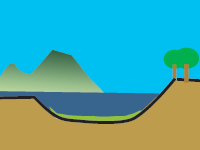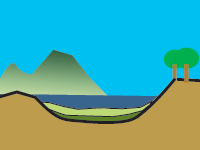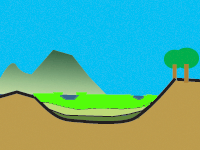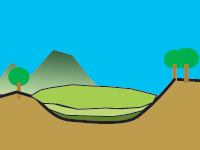| Formation of Burns Bog
|
||
Formation and Geology |
||
|
About 10,000 years ago 10,000 years ago was the end of the Pleistocene Glaciation. Glaciers were rapidly retreating but the entire region was still covered largely by ice. The sea level was significantly higher than what it is now. Burns Bog did not exist and the area was a depression filled with shallow sea water. The area would appear to be similar to this cross-section image. The North Shore Mountains would be covered by the glaciers. |
|

|
|
About 7,000 years ago The depression was still a tidal area after the end of the ice age. Because it was closed to the mouth of the Fraser River, there was significant amounts of silt and clay deposited on the bottom of the depression. Sea grass and rushes grew in the brackish water. The area became a tidal marsh, similar to Boundary Bay today. The remains of sea grasses and rushes did not fully decompose and accumulated at the bottom of the depression. |
|

|
|
About 5,000 years ago The main channel of Fraser River flowed next to the depression. The river built up natural dikes. This combined with the rising landmass at the larger scale changed the original position of the depression in relation to the sea level. The depression became less frequently flooded by tidal water. |
|

|
|
About 4,000 years ago The aquatic environment helped preserve dead plant material (peat). At this time, the peat did not yet contain Sphagnum moss, but was made up of mostly other woody and grassy plants. Gradually, rain water and groundwater became the principle source of water. The area became a fen, where true mosses grew. |
|

|
|
About 3,000 years ago to now Sphagnum mosses appeared at about 3,000 years before present. The surface gradually became separated from groundwater. The fen became a bog. Filled in by peat, the depression ceased to exist. After many years, the peat accumulated thicker near the centre of the Bog. 100 years ago, the surface of the Bog became separated from groundwater. There were small lakes in the Bog. These lakes where very acidic and not suitable for fish. The entire ecosystem stood in sharp contrast with its surroundings, which were predominantly alkaline and saturated with groundwater, and tidal water in some cases. All that has been transformed by human activities in the most recent 100 years. |
|

|